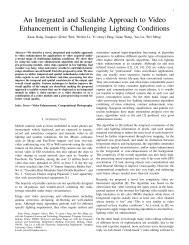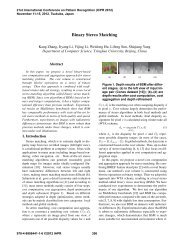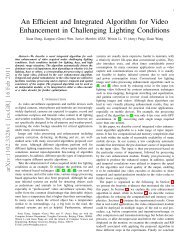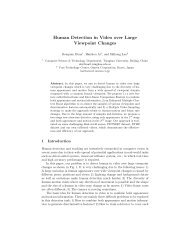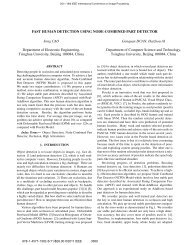Smart Classroom â an Intelligent Environment for distant ... - CiteSeerX
Smart Classroom â an Intelligent Environment for distant ... - CiteSeerX
Smart Classroom â an Intelligent Environment for distant ... - CiteSeerX
Create successful ePaper yourself
Turn your PDF publications into a flip-book with our unique Google optimized e-Paper software.
<strong>Smart</strong> <strong>Classroom</strong> – <strong>an</strong> <strong>Intelligent</strong> <strong>Environment</strong> <strong>for</strong> dist<strong>an</strong>t education<br />
Weikai Xie, Yu<strong>an</strong>chun Shi, Gu<strong>an</strong>you Xu<br />
Institute of Hum<strong>an</strong>-Computer Interaction <strong>an</strong>d Media Integration<br />
Department of Computer Science <strong>an</strong>d Technology<br />
Tsinghua University, P. R. China<br />
Abstract<br />
In this paper, we present our current work on <strong>Intelligent</strong> <strong>Environment</strong> - the <strong>Smart</strong> <strong>Classroom</strong><br />
project. It is <strong>an</strong> augmented classroom used <strong>for</strong> teachers in the dist<strong>an</strong>t education. The teacher c<strong>an</strong><br />
write directly on a wall-size media-board or use speech <strong>an</strong>d gesture to conduct the class discussion<br />
involving of the dist<strong>an</strong>t students. It is just the experience that the teacher was familiar with in the<br />
ordinary classroom educations. This paper explained the motivation of this project <strong>an</strong>d discussed<br />
the main challenges of the project, which we considered also have signific<strong>an</strong>ces to other<br />
<strong>Intelligent</strong> <strong>Environment</strong> projects. Our current progress <strong>an</strong>d the approaches we used are also<br />
described.<br />
Keywords: intelligent environment, interactive space, dist<strong>an</strong>t education, multimodal,<br />
context-awareness<br />
1 Introduction<br />
We are steadily moving into a new age of in<strong>for</strong>mation technology named as ubiquitous<br />
computing or pervasive computing, in which computation power <strong>an</strong>d network connection will be<br />
embedded <strong>an</strong>d available in the environments, on our bodies, <strong>an</strong>d in the numerous h<strong>an</strong>dhold<br />
in<strong>for</strong>mation appli<strong>an</strong>ces [1]. The hum<strong>an</strong> computer interaction paradigm we currently used on the<br />
desktop computers will not be sufficient [2]. Instead of we operating on individual computers <strong>an</strong>d<br />
dispatching m<strong>an</strong>y trivial comm<strong>an</strong>ds to separated applications through keyboard <strong>an</strong>d mouse, we<br />
should be able to interact with all involved computation devices as a whole, <strong>an</strong>d express our<br />
intended tasks in a high abstraction level <strong>an</strong>d by ways as natural as we used to communicate with<br />
other peoples in everyday life.<br />
The research titled as <strong>Intelligent</strong> <strong>Environment</strong> is just motivated by this vision. General<br />
speaking, <strong>an</strong> <strong>Intelligent</strong> <strong>Environment</strong> is <strong>an</strong> augmented living or working environment which could<br />
actively watch <strong>an</strong>d listen to the occup<strong>an</strong>ts, recognize their requirements <strong>an</strong>d attentively provide<br />
services <strong>for</strong> them. The occup<strong>an</strong>ts could use normal hum<strong>an</strong>-being interaction methods such as<br />
gesture <strong>an</strong>d voice to interact with the computer system operating the environment.<br />
The researches in this filed are bring into mainstream in the late 1990’s by several first-class<br />
research groups of the world such as AI Lab <strong>an</strong>d Media Lab in MIT, Xerox PARC, IBM <strong>an</strong>d<br />
Microsoft. Currently there are dozens of <strong>Intelligent</strong> <strong>Environment</strong> related projects, carried out in<br />
research groups from all over the world. Just to mention some most famous ones among them,<br />
they are <strong>Intelligent</strong> Room project from MIT AI Lab [3][4], Aware Home project from GIT [5] <strong>an</strong>d<br />
Easy Living project from Microsoft [6][7].<br />
The <strong>Smart</strong> <strong>Classroom</strong> project in our group is also a research ef<strong>for</strong>t on <strong>Intelligent</strong> <strong>Environment</strong>.<br />
It demonstrates <strong>an</strong> intelligent classroom used <strong>for</strong> teachers involved in dist<strong>an</strong>t educations, in which<br />
the teachers could use the same ways as they used when teaching in a real classroom to teach the
dist<strong>an</strong>t students. The real motivation under the demonstration is we w<strong>an</strong>t to identify the key<br />
challenges in the research of <strong>Intelligent</strong> <strong>Environment</strong>, <strong>an</strong>d at the same time to explore how the<br />
<strong>Intelligent</strong> <strong>Environment</strong> will influence the way people cooperate with the computers. One reason<br />
that we selected the dist<strong>an</strong>t education as the test-bed <strong>for</strong> <strong>Intelligent</strong> <strong>Environment</strong> research was<br />
<strong>an</strong>other group in our lab had already done years of work on it <strong>an</strong>d had accumulated valuable<br />
technologies <strong>an</strong>d experiences. Our project bears some similarities to the <strong>Classroom</strong>2000 project<br />
from GIT [8]. But there are major differences as well. Their project is focused on the<br />
automatically recording of the events occurred in the environments <strong>an</strong>d is <strong>for</strong> traditional classroom<br />
education only. However, our project is focused on providing a high abstraction level <strong>an</strong>d<br />
multi-modal hum<strong>an</strong>-computer interaction possibilities <strong>for</strong> the teacher in the environment, <strong>an</strong>d the<br />
system is used <strong>for</strong> dist<strong>an</strong>t education.<br />
In the following sections, we first introduce the scenario of the <strong>Smart</strong> <strong>Classroom</strong>, then comes<br />
to the discussion of some key issues in the implementation the <strong>Smart</strong> <strong>Classroom</strong>, which we think<br />
have signific<strong>an</strong>ces to other <strong>Intelligent</strong> <strong>Environment</strong> projects too, <strong>an</strong>d next we describe our current<br />
progress <strong>an</strong>d future work. Finally we end the paper with a conclusion.<br />
2 The Scenario<br />
Almost all the dist<strong>an</strong>t education systems developed now are so-called desktop-computing<br />
based, where the teacher is required to seat down in front of the desktop computer <strong>an</strong>d use the<br />
keyboard or mouse to conduct the dist<strong>an</strong>t education course. The teacher’s experience is of much<br />
difference from teaching in <strong>an</strong> ordinary classroom, where the teacher could use h<strong>an</strong>dwriting to<br />
make <strong>an</strong>notations on the blackboard, use speech <strong>an</strong>d gesture to involve the students in the class<br />
discussion <strong>an</strong>d use m<strong>an</strong>y natural interaction patterns like that. The different experience always<br />
makes the teacher feel uncom<strong>for</strong>table <strong>an</strong>d reduced the efficiency of the course as well.<br />
We considered the adopting of <strong>Intelligent</strong> <strong>Environment</strong> idea will perfectly resolve this<br />
problem by construct a augmented classroom where the teacher could use all those natural<br />
interaction patterns they are accustomed to teach the remote students.<br />
We deployed <strong>an</strong> experiment system in a room of our lab. We equipped two wall-sized<br />
projector systems in it. One is used to display the courseware prepared by teacher – <strong>an</strong> <strong>an</strong>alog of<br />
the blackboard in <strong>an</strong> ordinary classroom (we call it media-board) <strong>an</strong>d the other is used to display<br />
the image of the remote students (we call it student-board). Some cameras <strong>an</strong>d wireless<br />
microphone systems are also installed in the proper positions to capture the teacher’s video <strong>an</strong>d<br />
voice.<br />
The display of the remote students’ client software is synchronized with that of the<br />
media-board in the classroom, i.e., whatever ch<strong>an</strong>ges the teacher makes on the media-board will<br />
be reflected on the remote student’s client software. The captured audio <strong>an</strong>d video in the room are<br />
multi-casted to the remote students’ sites too. If the teacher w<strong>an</strong>ts a remote student to give<br />
utter<strong>an</strong>ce on the class, he (she) c<strong>an</strong> enable this student’s up-link audio/video ch<strong>an</strong>nels so that the<br />
student’s audio <strong>an</strong>d video will be sent both to the room <strong>an</strong>d other remote students’ sites.<br />
The scenario seems no big difference with m<strong>an</strong>y other whiteboard based dist<strong>an</strong>t learning<br />
systems. However, the magic of the <strong>Smart</strong> <strong>Classroom</strong> is the way the teacher using the system – the<br />
teacher no longer need to tied up to the desktop computer using the cumbersome keyboard <strong>an</strong>d<br />
mouse to interact with the dist<strong>an</strong>t education system. Making <strong>an</strong>notations on the courseware<br />
displayed on the media-board is just as easy as writing on <strong>an</strong> ordinary classroom blackboard, i.e.
event:<br />
FocusPosition(X,Y)<br />
event: FingerOn/Move/Up(X,Y)<br />
event: H<strong>an</strong>dGesture(Kind)<br />
event: Spoken(PhraseID)<br />
method:<br />
AddLexicon(Phrase,PhraseID)<br />
the teacher only need to move his finger, then the stroke will be displayed on the media-board <strong>an</strong>d<br />
overlapped with the courseware displayed. The teacher could also point to something displayed<br />
the media-board <strong>an</strong>d say some words to complete the action he w<strong>an</strong>ted, such as erasing the<br />
<strong>an</strong>notations previously made, scrolling the page up <strong>an</strong>d skipping to <strong>an</strong>other page. Nevertheless, the<br />
way to switch the remote students’ utter<strong>an</strong>ce right is intuitive <strong>an</strong>d easy. Each attended remote<br />
student will have <strong>an</strong> image displayed on the student-board to represent him. Whenever a student<br />
requires the utter<strong>an</strong>ce right, his corresponding image will start to blink to alert the teacher. In order<br />
to gr<strong>an</strong>t the utter<strong>an</strong>ce right to a selected student, the teacher only need to use a laser-pen to point at<br />
the image representing the student.<br />
All these interaction patterns are of much similarity to what happed on <strong>an</strong> ordinary classroom.<br />
In fact, we deliberately hide all the computers running the room’s software out of the sight, just to<br />
give the teacher a feeling that they are not using some computer programs but teaching in a real<br />
classroom.<br />
Media-Board:<br />
Its content is<br />
synchronized<br />
with the remote<br />
students's<br />
client program<br />
Cameras:<br />
Used to track<br />
the teacher's<br />
h<strong>an</strong>d movement<br />
<strong>an</strong>d h<strong>an</strong>d<br />
gesutre<br />
Student-Board:<br />
The live video/<br />
audio of the<br />
remote student<br />
will only be<br />
played here when<br />
he(she) is<br />
gr<strong>an</strong>ted the<br />
utter<strong>an</strong>ce right<br />
Remote<br />
Students<br />
智 能 教 室 第 一 阶 段 设 计<br />
模 块 划 分 和 接 口 示 意<br />
Post Windows<br />
Whiteboard Message<br />
Application<br />
Laser Pen<br />
Tracking<br />
Agent<br />
Whiteboard<br />
Agent<br />
SR Agent<br />
H<strong>an</strong>d Tracking<br />
Agent<br />
Studentboard<br />
Agent<br />
Local<br />
Students<br />
Actually, this system blurs the differences of the ordinary classroom education <strong>an</strong>d the dist<strong>an</strong>t<br />
education. The teacher c<strong>an</strong> give a course to the local students on the <strong>Smart</strong> <strong>Classroom</strong> <strong>an</strong>d those<br />
remotely attended students at the same time.<br />
Another appealing feature of the <strong>Smart</strong> <strong>Classroom</strong> is the ability to automatically capture the<br />
threads of the class. Any words the teacher said, <strong>an</strong>y <strong>an</strong>notations the teacher made on the materials,<br />
<strong>an</strong>d <strong>an</strong>y discussions took place on the class, plus the original courseware will be recorded in a<br />
hypertext documents with time stamps, which could be used to replay the class back <strong>for</strong> review or<br />
to generate a new courseware with a post-edit toolkit.<br />
3 Key Research Issues in the <strong>Smart</strong> <strong>Classroom</strong> Project<br />
In the process of designing the <strong>Smart</strong> <strong>Classroom</strong>, we identified several key research issues of
it, <strong>an</strong>d we think that they will be the main play-fields in the research of <strong>Intelligent</strong> <strong>Environment</strong><br />
too.<br />
3.1 The right modal of the software structure<br />
The <strong>Smart</strong> <strong>Classroom</strong>s, just like m<strong>an</strong>y other similar <strong>Intelligent</strong> <strong>Environment</strong> setups, will<br />
assemble a good number of hardware <strong>an</strong>d software modules such as projectors, cameras, sensors,<br />
face recognition module, speech recognition module <strong>an</strong>d eye-gaze recognition module. It is<br />
unimaginable to install all these components in one computer due to the limited computation<br />
power <strong>an</strong>d terrible mainten<strong>an</strong>ce requirements. Thus, a distributed computing structure is required<br />
to implement <strong>an</strong> <strong>Intelligent</strong> <strong>Environment</strong>.<br />
There are several commercial available distributed computing structures such as DCOM,<br />
CORBA <strong>an</strong>d EJB. They are all based on the distributed component modal. Under this modal,<br />
software should have a central logic <strong>an</strong>d several other peripheral objects offer service to the<br />
central logic. The objects run only when invoked by the central logic. We call this software<br />
structure as monolithic. We considered this modal is not sufficient as a computing structure <strong>for</strong> the<br />
<strong>Intelligent</strong> <strong>Environment</strong>. The reason is<br />
1. The scenarios of <strong>an</strong> <strong>Intelligent</strong> <strong>Environment</strong> are usually very complex. Developing a<br />
central logic <strong>for</strong> it is very difficult even <strong>an</strong> unpractical matter.<br />
2. The scenarios <strong>an</strong>d configurations in <strong>an</strong> <strong>Intelligent</strong> <strong>Environment</strong> are often very dynamic.<br />
New functions will be added, old module will be revised, <strong>an</strong>d all those things are<br />
happened continuously. The monolithic approach is very inflexible under this situation,<br />
because <strong>an</strong>y trivial modifications will require the whole system to shut down <strong>an</strong>d all<br />
modules in the system should be re-linked.<br />
3. The central logic is likely to be the bottleneck of the system.<br />
To summary up, the distributed components modal is a tightly coupled system, which could not<br />
accommodate the dynamic <strong>an</strong>d complexity of the <strong>Intelligent</strong> <strong>Environment</strong> system. Instead, we<br />
need a modal in which the modules are more loosely coupled. Fortunately, we already have one,<br />
the multi-agent system (MAS) modal, which have been invented <strong>an</strong>d used <strong>for</strong> years in the AI<br />
domain. According to this modal, a system is constituted by m<strong>an</strong>y individual software modules<br />
called agents. An agent has its own executing process <strong>an</strong>d is autonomous by itself. Each agent has<br />
limited capabilities <strong>an</strong>d limited knowledge of the functions of the whole system, but through<br />
communications <strong>an</strong>d cooperations the agents’ community will expose a high degree of intelligence<br />
<strong>an</strong>d c<strong>an</strong> achieve very complex functions. We considered it a right solution as the software<br />
structure <strong>for</strong> the <strong>Intelligent</strong> <strong>Environment</strong>, i.e., the software of <strong>an</strong> <strong>Intelligent</strong> <strong>Environment</strong> should<br />
be modeled as a multi-agent system.<br />
3.2 Other necessary features of the software architecture<br />
1. A mech<strong>an</strong>ism to reference modules (agents) by some high-level description<br />
In order to <strong>an</strong> agent to communicate with each other, it should have a reference to the other<br />
peer. In order to make the system more loosely coupled <strong>an</strong>d flexible, the reference binding<br />
should be created by some high-level mech<strong>an</strong>ism. A usual implementation is binding by<br />
capability. That is to say, on startup, each agent should register its capabilities to some central<br />
registry, <strong>an</strong>d when <strong>an</strong> agent needs some service, it could ask <strong>for</strong> it by describe the needed<br />
capabilities. However, the true challenge here is how to set up a framework <strong>for</strong> the description
of the capabilities, which could enable a new agents to find out the exact sem<strong>an</strong>tic me<strong>an</strong>ing of<br />
the capabilities advertised by other agents. For example, if <strong>an</strong> agent developed by some other<br />
group is introduced into <strong>an</strong> existing agent society <strong>an</strong>d it needs a TTS service, which words<br />
should it uses to express its requirement? Is it “say”, “speak” or just “TTS”? Maybe the final<br />
solution of this problem only lies in the achievement of the NLP technology.<br />
2. A mech<strong>an</strong>ism to encapsulate legacy programs (, which should be easy to grasp)<br />
When implementing <strong>an</strong> <strong>Intelligent</strong> <strong>Environment</strong> project, we usually w<strong>an</strong>t to exploit the<br />
capabilities of m<strong>an</strong>y legacy programs. After all, to build all the things bottom up is neither<br />
necessary nor practical. Thus the software architecture should provide a simple <strong>an</strong>d clear<br />
migration path to bring those legacy programs in, making them a legal resident of the agent<br />
society.<br />
3. A mech<strong>an</strong>ism to ensure consistent response time<br />
M<strong>an</strong>y perception modules in <strong>an</strong> <strong>Intelligent</strong> <strong>Environment</strong> setup, especially vision algorithm<br />
modules, are so-called resource-hungered. They c<strong>an</strong> easily exhaust all the capacity of a latest<br />
high-end computer <strong>an</strong>d their response time tend to vary during times. The situation is even<br />
worse when multiple modules coexist in one computer. This will be rather bothering to the user.<br />
For example, suppose the user points to one object in the environment <strong>an</strong>d asks some<br />
in<strong>for</strong>mation <strong>for</strong> it. Due to the overload of the h<strong>an</strong>d-tracking module, the system c<strong>an</strong>’t give the<br />
response until a later time. However, the user might think the system c<strong>an</strong>’t recognize his<br />
behavior <strong>an</strong>d start to do something else. And when the delayed response eventually comes, its<br />
only result is making the user very confused. There<strong>for</strong>e, a mech<strong>an</strong>ism to guar<strong>an</strong>tee a consistent<br />
response time is very necessary to make <strong>an</strong> <strong>Intelligent</strong> System useful in practice.<br />
4. Feasible facilities <strong>for</strong> debugging<br />
As mentioned above, the software in the <strong>Intelligent</strong> <strong>Environment</strong> is composed of m<strong>an</strong>y<br />
software modules (agents) running in their own processes. Misbehaviors of one agent are<br />
usually related to the states of m<strong>an</strong>y other agents. This makes debugging of the system very<br />
difficult because you should bring all related agents into their exact states as the error occurring,<br />
in order to replay the error. According to our knowledge, currently there is no debug tool<br />
available that c<strong>an</strong> address this problem. There<strong>for</strong>e, the software architecture should build some<br />
debug facilities in it, such as centralized logging <strong>an</strong>d centralized agents m<strong>an</strong>agement interface.<br />
3.3 Multi-modal processing capability<br />
People use multiple modalities to communicate with each other in everyday life, such as<br />
speaking, pointing <strong>an</strong>d gestures. The multi-modal interaction capability is a fundamental<br />
requirement of the <strong>Intelligent</strong> <strong>Environment</strong>, because a single modality is often sem<strong>an</strong>tic<br />
incomplete. For example, when one say “move it to right”, without the recognition of the h<strong>an</strong>d<br />
pointing modality we could not tell which object is referred by the speaker. Another benefit of the<br />
multi-modal processing is the in<strong>for</strong>mation from other modalities often helps to improve the<br />
recognition accuracy of a single modality. For example, suppose in a noise environment, a not so<br />
smart SR algorithm maybe has difficulty to decide what the user said is “move to right” or “move<br />
to left”. But after referring the in<strong>for</strong>mation from the h<strong>an</strong>d gesture recognition module, the system
could eventually make the right choice.<br />
This also happens to <strong>Smart</strong> <strong>Classroom</strong>. In the scenario we designed, the teacher c<strong>an</strong> use<br />
speech <strong>an</strong>d h<strong>an</strong>d gesture to make <strong>an</strong>notations on the media-board, to m<strong>an</strong>age the content in the<br />
media-board <strong>an</strong>d to control the utter<strong>an</strong>ce right of the remote students.<br />
Currently, some adv<strong>an</strong>ces have been made in the multi-modality processing research. The<br />
most famous approach is the one used in the Quickset project [9]. It essentially takes the<br />
multi-modality integration process as a kind of l<strong>an</strong>guage parsing process, i.e., each separate action<br />
in a single modality is considered as a phrase structure in the multi-modal l<strong>an</strong>guage grammar, they<br />
are grouped <strong>an</strong>d induced to generate a new higher level phrase structure. The process is repeated<br />
until a sem<strong>an</strong>tic completed sentence is found. The process could also help to correct the wrong<br />
recognition result of one modality. If one phrase structure could not be grouped with <strong>an</strong>y other<br />
phrase structure according to the grammar, it will be regarded as a wrong recognition result <strong>an</strong>d<br />
will be ab<strong>an</strong>doned. Although the method is focused on the pen-based computer, it could be used<br />
into the <strong>Intelligent</strong> <strong>Environment</strong> research as well after some modifications.<br />
3.4 Take context into account<br />
In order to determine the exact intention of the user in the <strong>Intelligent</strong> <strong>Environment</strong>, the<br />
context in<strong>for</strong>mation should also be taken into account. For example, in the <strong>Smart</strong> <strong>Classroom</strong>,<br />
when the teacher says “turn to the next page”, dose he me<strong>an</strong>s the courseware displayed on the<br />
media-board should be switched to the next page or just tells the students to turn their textbooks to<br />
the next page? Here the multi-modal integration mech<strong>an</strong>ism could not resolve the ambiguity<br />
because the teacher just says the comm<strong>an</strong>d without <strong>an</strong>y additional gestures. However, we could<br />
easily tell the teacher’s exact intention by recognizing where he st<strong>an</strong>ds <strong>an</strong>d what he faces.<br />
We consider that the context in <strong>an</strong> <strong>Intelligent</strong> <strong>Environment</strong> generally include the following<br />
factors:<br />
1. Who is there?<br />
A natural <strong>an</strong>d sophisticated way to acquire this in<strong>for</strong>mation is through the person’s biology<br />
character, such as face, acoustic, foot print <strong>an</strong>d so on.<br />
2. Where is the person located?<br />
This in<strong>for</strong>mation could be acquired by vision tracking. In order to the result from the vision<br />
tacking module could be interpreted by other modules in the system, a geometric modeling<br />
of the environment is also needed.<br />
3. What are ongoing in the environment?<br />
This in<strong>for</strong>mation including the action the user explicitly takes <strong>an</strong>d others implied in the<br />
user’s behaviors. The <strong>for</strong>mer one could be acquired by multi-modal recognition <strong>an</strong>d<br />
processing. However, there is no <strong>for</strong>mal approach available dealing with the latter problem<br />
indeed using our current AI technologies except some ad-hoc methods.<br />
4 Our approach <strong>an</strong>d current progress<br />
We have currently completed a first-stage demo of the <strong>Smart</strong> <strong>Classroom</strong>. The system is<br />
composed of the following key components.<br />
1. The multi-agent software plat<strong>for</strong>m.<br />
We adopted a public available multi-agent system, OAA (Open Agent Architecture), as<br />
the software plat<strong>for</strong>m <strong>for</strong> the <strong>Smart</strong> <strong>Classroom</strong>. It was developed by SRI <strong>an</strong>d has been used by
m<strong>an</strong>y research groups [10]. We fixed some errors of the implementation provided by SRI to<br />
make it more robust. All the software modules in the <strong>Smart</strong> <strong>Classroom</strong> are implemented as the<br />
agents in the OAA, <strong>an</strong>d using the capability provided by it to communicate <strong>an</strong>d cooperate<br />
with each other.<br />
2. The dist<strong>an</strong>t education supporting system<br />
It is based on the dist<strong>an</strong>t education software called Same View from <strong>an</strong>other group in our<br />
lab. The system is constituted of three layers. The most upper layer is a multimedia<br />
whiteboard application we called media-board <strong>an</strong>d associated utter<strong>an</strong>ce right control<br />
mech<strong>an</strong>ism. As mentioned above, one interesting feature of the media-board is it c<strong>an</strong> record<br />
all the actions on it, which could be used to aid the creation of the courseware. The middle<br />
layer is a self-adapting content tr<strong>an</strong>s<strong>for</strong>m layer, which could automatically re-authorizing or<br />
tr<strong>an</strong>s-coding the content sent to the user according to the user’s b<strong>an</strong>dwidth <strong>an</strong>d device<br />
capability [11]. The media-board use this feature to ensure that students at different sites could<br />
get the contents on the media-board at a maximum quality according to their different network<br />
<strong>an</strong>d hardware conditions. The lowest layer is a reliable multicast tr<strong>an</strong>sport layer called Totally<br />
Ordered Reliable Multicast (TORM), which could be used in a WAN environment where<br />
sub-networks capable of or incapable of multicast coexist [12][13]. The media-board uses this<br />
layer to improve its scalability across large networks like Internet.<br />
3. The h<strong>an</strong>d-tracking agent.<br />
The agent could track the 3D movement parameters of the teacher’ h<strong>an</strong>d using a skin<br />
color consistency based algorithm. It could also recognize some simple actions of the<br />
teacher’s palm such as open, close <strong>an</strong>d push [14]. The same recognition engine had been<br />
successfully used in a project in Intel China Research Center (ICRC), which we have taken<br />
part in.<br />
4. The multi-modal unification agent.<br />
The agent is based on the work in the project of ICRC mentioned above, under a<br />
collaboration agreement. The approach is essentially based on the one used in Quickset as<br />
mentioned above.<br />
5. The speech recognition module.<br />
The speech recognition agent is developed with a simplified Chinese version of ViaVoice<br />
SDK from IBM. We carefully designed the interface to make <strong>an</strong>y agents who need the SR<br />
capability could dynamically add or delete the recognizable phrases together with the<br />
associated action (<strong>an</strong> OAA resolve request indeed) when recognized. Thus the vocabulary in<br />
the SR agent is always kept to a minimum size according to the context of the time. It is very<br />
import<strong>an</strong>t to improve the recognition rate <strong>an</strong>d accuracy.<br />
In the next stage, we pl<strong>an</strong>ed to add other computer vision capabilities needed in the scenario,<br />
such as face tracking, pointing tracking. Another import<strong>an</strong>t thing under consideration is to develop<br />
a framework <strong>for</strong> the agents in the system to exch<strong>an</strong>ge their knowledge in order to make a better<br />
use of the context in<strong>for</strong>mation. We also w<strong>an</strong>t to introduce the acoustic-recognition <strong>an</strong>d<br />
face-recognition program developed by other groups in our lab into the scenario. These<br />
technologies could be used to identify the teacher automatically <strong>an</strong>d then provide personalized<br />
services to him (her). An example is the classroom could automatically resume the context (such<br />
as the content on the media-board) where the teacher stopped at the last class.
5 Conclusion<br />
We believe the <strong>Intelligent</strong> <strong>Environment</strong> will be the right metaphor <strong>for</strong> people to interact with<br />
the computer systems in the ubiquitous computing age. The <strong>Smart</strong> <strong>Classroom</strong> project is started as<br />
a test-bed <strong>for</strong> the research issues of the <strong>Intelligent</strong> <strong>Environment</strong> <strong>an</strong>d also as <strong>an</strong> illustration of its<br />
application. We are just achieved the first stage of the work <strong>an</strong>d will continue our ef<strong>for</strong>t in future<br />
work.<br />
References<br />
1. Mark Weiser. The Computer <strong>for</strong> the 21 st Century. Scientific Americ<strong>an</strong>. pp. 94-10,<br />
September 1991.<br />
2. Mark Weiser. The world is not a desktop. Interactions, pages 7--8, J<strong>an</strong>uary 1994.<br />
3. Coen, M. Design Principles <strong>for</strong> <strong>Intelligent</strong> <strong>Environment</strong>s. In Proceedings of The<br />
Fifteenth National Conference on Artificial Intelligence. (AAAI98). Madison ,<br />
Wisconsin. 1998.<br />
4. Coen, M. The Future Of Hum<strong>an</strong>-Computer Interaction or How I learned to stop worrying<br />
<strong>an</strong>d love My <strong>Intelligent</strong> Room. IEEE <strong>Intelligent</strong> Systems. March/April. 1999.<br />
5. Kidd, Cory D., Robert J. Orr, Gregory D. Abowd, et al. The Aware Home: A Living<br />
Laboratory <strong>for</strong> Ubiquitous Computing Research. In the Proceedings of the Second<br />
International Workshop on Cooperative Buildings - CoBuild'99, Position paper,<br />
October 1999.<br />
6. Steven Shafer, et al. The New EasyLiving Project at Microsoft Research.<br />
Proceedings of the 1998 DARPA/NIST <strong>Smart</strong> Spaces Workshop, July 1998, pp.127-130.<br />
7. Brumitt, B. L., Meyers, B., Krumm, J., et al. EasyLiving: Technologies <strong>for</strong><br />
<strong>Intelligent</strong> <strong>Environment</strong>s. H<strong>an</strong>dheld <strong>an</strong>d Ubiquitous Computing, 2nd Intl. Symposium,<br />
September 2000, pp. 12-27.<br />
8. G. D. Abowd. <strong>Classroom</strong> 2000: An experiment with the instrumentation of a living<br />
educational environment. IBM Systms Journal, Vol. 38. No.4<br />
9. Michael Johnston .Unification-based multimodal parsing. In the Proceedings of<br />
the 17th International Conference on Computational Linguistics <strong>an</strong>d the 36th Annual<br />
Meeting of the Association <strong>for</strong> Computational Linguistics (COLING-ACL 98), August<br />
98, ACL Press, 624-630.<br />
10. http://www.ai.sri.com/~oaa/<br />
11. Liao Chunyu<strong>an</strong>, Shi Yu<strong>an</strong>chun, Xu Gu<strong>an</strong>gyou. AMTM – An Adaptive Multimedia<br />
Tr<strong>an</strong>sport Model. In proceeding of SPIE International Symposia on Voice, Video <strong>an</strong>d<br />
Data Communication, Boston, Novermeber 5-8, 2000.<br />
12. Pei Yunzh<strong>an</strong>g, Liu Y<strong>an</strong>, Shi Yu<strong>an</strong>chun,Xu Gu<strong>an</strong>gyou. Totally Ordered Reliable<br />
Multicast <strong>for</strong> Whiteboard Application. In proceedings of the 4 th<br />
International<br />
Workshop on CSCW in Design, Paris, Fr<strong>an</strong>ce, 1999.<br />
13. T<strong>an</strong> Kun, Shi Yu<strong>an</strong>chun, Xu Gu<strong>an</strong>gyou. A practical sem<strong>an</strong>tic reliable multicast<br />
architecture. In proceedings of the third international conference on multimodal<br />
interfaces,BeiJing,China,2000.<br />
14. Haibing Ren, Yu<strong>an</strong>xin Zhu, Gu<strong>an</strong>gyou Xu, Xueyin Lin, Xiaoping Zh<strong>an</strong>g.<br />
Spatio-temporal appear<strong>an</strong>ce modeling <strong>an</strong>d recognition of continuous dynamic h<strong>an</strong>d<br />
gestures. Chinese Journal of Computers (in Chinese),1999. Vol 23, No. 8 , Agu.2000,
pp.824-828.




